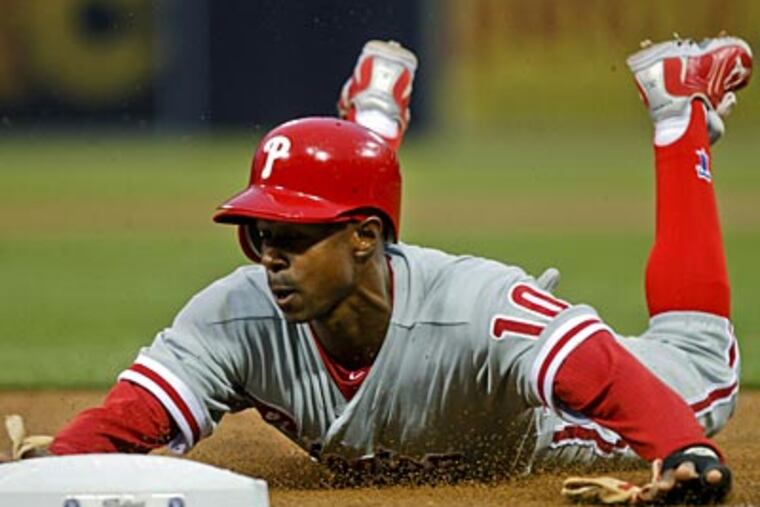Phillies looking for Pierre to cut down on base-running outs

Heading into the Phillies series-finale against the Cubs Monday night, Juan Pierre was one of the team's most consistent hitters, carrying a .318 batting average and a .348 on base percentage. But he also led the team in outs on the base paths, having been caught stealing twice, picked off once and thrown out at second while attempting to advance on a passed ball.
While Pierre had reached base 24 times, he had been eliminated on the base paths four times. If you only factored the times that he reached base and remained there into his OBP, the number would drop from .348 to .290.
"Especially when you aren't hitting, it works against you, because you only get 27 outs," first base coach Sam Perlozzo acknowledged before Monday night's game. "You can't give them away."
The first inning of Sunday's 5-1 loss to the Cubs was a microcosm of the Phillies' offensive struggles during the first three-plus weeks of the 2012 season. Jimmy Rollins led off the game with a fly ball that dropped into shallow right-center for a base hit, but was quickly eliminated at second base when Pierre grounded into a force out. Then, with one out, Pierre was thrown out at second when he attempted to advance on a Matt Garza pitch that eluded Wellington Castillo.
"Whatever they are doing, everybody is trying to make the big play," said Perlozzo, who replaced Davey Lopes as the team's base-running coach prior to last season. "When it's not there, you can't do that. It's not so much how many bases you steal all the time. If they aren't there, they aren't there. You want to have a good chance when you take it. When you do, you are going to be successful when you are supposed to.
"Especially when you aren't hitting, it works against you, because you only get 27 outs. You can't give them away."
The Phillies entered last night leading the National League in stolen base percentage, having converted 16-of-18 attempts for an 89 percent success rate. They have finished atop the NL in each of the last five seasons, with success rates ranging between 80 and 88 percent. During that time frame, the Phillies have been one of the most efficient base-running teams in the league. Last year, they were picked off just 13 times (tied for the second-lowest in the NL) and gave away just 45 outs on the base paths (2nd fewest in NL), not including stolen base attempts. Heading into Monday night's game, the Phillies had given away eight outs on the base paths, tied for the seventh-most in the NL, which is particularly disconcerting when you consider that they had put fewer runners on base than all but one NL team to begin with.
As far as Pierre is concerned, Perlozzo's main focus is on the size of the lead that the veteran left fielder is getting. Last year, Pierre was picked off seven times, tied for the most in the American League, where he was a member of the White Sox. Pierre was caught stealing 17 times, which also led the AL. His 61 percent success rate on stolen base attempts was the lowest among AL base runners with at least 25 attempts.
"I've talked to him about it," Perlozzo said. "I asked him not too long ago - he'll flinch when the guy goes home, and that tells me you are either out there too far or you are thinking about him throwing over. If you're not 100 percent going to second base, if you are 50 coming back and 50 going to second, good things usually don't happen."
The Phillies' speed players -- Pierre, Shane Victorino and Jimmy Rollins -- have the green light to steal on most occasions. Charlie Manuel can choose to put the red light on in certain situations. For the most part, the player himself decides when to go. During each pitch, Perlozzo times the pitcher's delivery to the plate. He then relays that information to the baserunner, who uses it when he makes his decision on whether to go.
"I think he's feeling for it a little bit right now," Perlozzo said. "He's just trying to force it to make something happen."